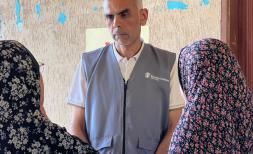Girls have 'mountain to climb' to achieve same opportunities as boys

Co-authored by Helle Thorning-Schmidt, CEO of Save the Children International, and Kevin Watkins, CEO of Save the Children UK
First published on Huffington Post.
In the time it takes you to read this article, at least 45 girls under 15 will marry. That’s one girl every 7 seconds.
Today is the International Day of the Girl Child, and while there is much to celebrate, there is still a mountain to climb until we reach a world in which girls will have the same opportunities as boys.
Today we think about girls like Zahra, a pregnant 14-year-old girl set alight by her husband in Afghanistan after reportedly being stabbed and tortured by his family. She later died in hospital. Zahra was married off at the age of 11. She lost her childhood – and life – as a result.
Zahra’s experience was extreme in its brutality and inhumanity, but it reflects a world in which poverty and discrimination combine to deny millions of children the right to survive, learn and be safe – simply because they are girls. A world in which every year 15 million children become brides; in which twice as many girls as boys never start an education, and many more fail to complete it; and in which childbirth is the second cause of death for adolescent girls.
Without action to tackle the barriers that prevent girls from surviving, learning and fulfilling their potential, we will jeopardise the global goals adopted only last year by the world’s governments. The reverse is also true. Investing in girls is the smart thing to do, as well as the right thing, and will not only transform the lives of millions of children, but also ensure a better future for their children, breaking the passage of poverty from one generation to the next.
Tackling child marriage is one of the surest ways of us realizing this girls’ development dividend. The numbers can appear overwhelming: one quarter of all married women were child brides, and in countries including Bangladesh, Mali and Niger, two thirds of girls are married before their eighteenth birthday. And current progress towards the UN target of ending child marriage by 2030 is painfully slow. At just one percent a year, the rate of reduction is one eighth of what’s needed.
But the case for action is compelling. Girls who marry early see their education cut short, at precisely the point where the social and economic payback from education is highest. While the gap in primary school enrolment for boys and girls has closed dramatically, girls are far more likely than boys to drop out of secondary school. Child brides also become child mothers. 90 percent of teenage pregnancies around the world are to married girls. These girls are giving birth before their bodies are ready, endangering themselves and their children: babies born to adolescent mothers are 50 percent less likely to survive than children whose mothers are over 18. And girls who marry are exposed to heightened risks of violence and abuse. Half of all child brides have husbands at least ten years older than them, often making it doubly difficult to have an equal voice.
Today Save the Children launches a new report “Every Last Girl” as part of our global campaign to secure the rights of the world’s most excluded children. As our report shows, child marriage is a complex problem that has to be addressed at different levels. Laws and international standards can send a powerful signal that girls have a right to a childhood. Through the new Sustainable Development Goals, every single country has re-affirmed its commitment to eliminate harmful practices against children, including child marriage. The UN General Assembly, Human Rights Council and the African Union have all committed to eradicate the practice. And a raft of countries with high rates of child marriage, including Gambia, Tanzania and Zimbabwe, have all recently ratified legislation banning the practice.

But this is not an issue that can simply be legislated out of existence. Often, girls are becoming brides because of family poverty and insecurity. Giving the poorest families cash transfers so that they can afford to keep their daughters in school, and delay marriage, shows promising results in many countries. Making schools safe for girls and sensitive to their needs, especially once they reach puberty, can often be the difference between attendance and dropping out. And ensuring that girls have the knowledge and healthcare they need to delay and plan pregnancy is crucial not only to their health, but also to their lifelong economic opportunities. We have to recognize too that child marriage is often a deep-seated social convention, and organisations like ours must get better at supporting the growing movement of people, from religious leaders to women’s organisations, who recognize that child marriage is a threat to girls’ futures, and are working to challenge and change attitudes and practices.
We are building our work in this area. From Somalia, where we are working with mosques, to Bangladesh, where we are supporting girls’ groups in Sylhet, we are seeing the powerful impact that can be achieved for girls where we collaborate with communities.
What strikes us most when we see this work is the extraordinary courage, energy and commitment of so many girls to tackle these issues themselves. This is what inspires hope. Supporting this future generation of leaders, and ensuring that their voices are heard – in communities, in national capitals, and on the world stage – will be critical to the goal of ending child marriage, and transforming the lives of millions of children.
The bitter truth is that no one solution will end child marriage; there is no quick fix. It is the sum of all our work across all levels that will see the practice become obsolete. The International Day of the Girl is a reminder of why we cannot relent in this mission.







